File System Management
92
7210 SAS-M, T, R6, R12, Mxp, Sx, S Basic System
Configuration Guide
3HE 16132 AAAB TQZZA Edition: 01
• The 7210 SAS auto detects the device type when any supported device is
connected to the USB interface. Only approved USB mass storage device and
optical clip-on devices plugged in to the USB port are recognized as valid
devices. The use of unsupported devices generates error logs.
• Nokia recommends that the user should run the shutdown command before
removing the USB storage device.
3.1.3 Storage Locations for Accounting, Logs, Index File,
and Images
The default location for accounting records, logs, and others is set to point to cf1:\.
The following applies to storage locations on 7210 SAS-T, 7210 SAS-Mxp,
7210 SAS-Sx/S 1/10GE, 7210 SAS-Sx 10/100GE, 7210 SAS-R6, and
7210 SAS-R12 platforms.
• On the 7210 SAS-T, 7210 SAS-R6, and 7210 SAS-R12, the default location for
accounting records and logs is set to cf1:\. The user can change it to either cf2:\
or uf1:\.
• If the license is purchased for the 7210 SAS-T and 7210 SAS-Mxp, these
platforms are factory-shipped with the boot.tim and the BOF on cf1:\. Nokia
recommends that you should not move these files from cf1:\ on these platforms.
• If the license is purchased for the 7210 SAS-Sx 1/10GE, 7210 SAS-S 1/10GE,
7210 SAS-Sx 10/100GE, 7210 SAS-R6, and 7210 SAS-R12, these platforms
are factory-shipped with the boot.tim and starter BOF on cf2:\. The user can
choose to copy these files to the internal flash cf1:\, if need be.
Note: This feature is supported on all 7210 SAS platforms as described in this document,
except the 7210 SAS-M.
Note: Nokia recommends you should not store frequently written objects such as
accounting records, system logs, and others on the internal flash (cf1:\), as it is non-
replaceable. to store only systems images, configuration files, persistence database,
nvsys.info, and QoS SAP resource map (the sdx file). Use the external flash (cf2:\) or use
uf1:\ to store frequently written objects (as applicable).

